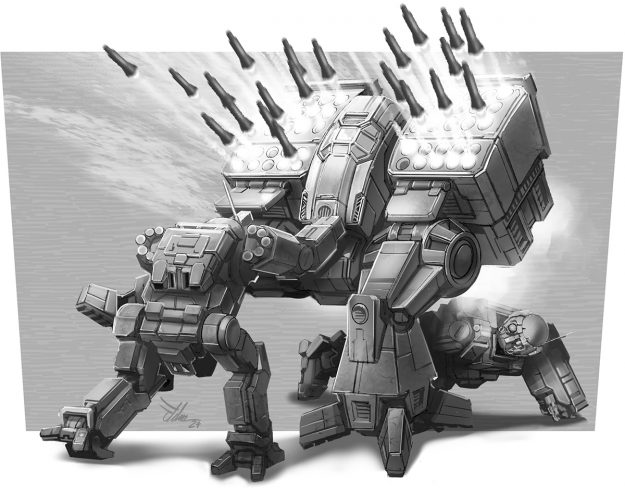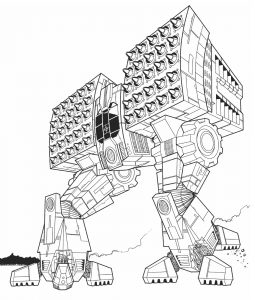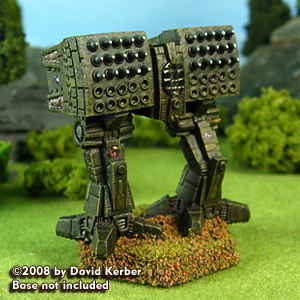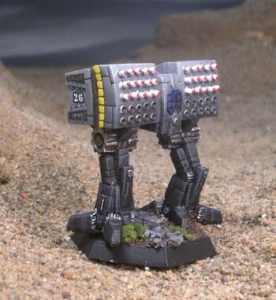
Courtesy of Eldoniousrex
Sergeant Bixonnen had fallen and couldn’t get up.
It wasn’t entirely her fault. Being struck by counter-battery fire isn’t expected to be a walk in the park for anyone, let alone a 60-ton walking death machine. What complicated the issue for her was that her Yeoman didn’t have arms--not really. Although labeled arms on her damage schematic, the boxy protrusions just contained a pair of long-range missile launchers that gave her ‘Mech impressive fire support capabilities.
When it was standing. Laying on its back, her Yeoman was little more than a 60-ton paperweight.
The irony was that she really wasn’t all that damaged. The likely Long Tom blast (she couldn’t say for sure, but the size of the explosion seemed a big hint) had removed a significant amount of her frontal armor, but the Yeoman was fairly well protected for an artillery ‘Mech. Far better than the LRM Carriers that her external cameras confirmed were smoldering wrecks around her. But she might as well have been a smoldering wreck for all the good her ablative protection did.
Bixonnen knew that it was theoretically possible to right her ‘Mech without the help of upper limbs. She’d seen Solaris fighters do it, and amputee infantry did it all the time. At least, they did on the inspirational holos that she’d often watch before drifting off to sleep. A lot of them performed a sort of martial arts trick that she didn’t think was possible at 60 tons, but the rest of them just had to roll over onto their front, put one leg underneath, and then push.
She tried just as she saw on the holos, envisioning herself rocking side-to-side a few times before finally tipping onto her front. The only problem was that she had two giant boxes on either side that prevented her from so much as budging. All she managed to do was scrape yet more armor off her backside.
“Fire support, fire support, calling for grid coordinate zero alpha three six nine, fire for effect!”
It was Captain Scarl. It sounded like the front lines were taking a pounding, but there was little she could do about it.
“Sorry sir, this is Fire Lance Charlie, we’ve been hit by counter-battery fire. The firebase is a wreck and I’m flat on my back, over.”
Scarl’s response was equal parts urgency and fury. “Bixonnen, I don’t care if you’re fending off the third coming of Kerensky! We’re getting slaughtered out here, and we need fire support NOW!”
Bixonnen flinched in her neurohelmet. She once again checked her external sensors to confirm that the three LRM Carriers and both J-27 Ordinance Trucks were either on fire or had been replaced by craters. Support staff were only now reaching the wounded while others wandered away from the blast zone like zombies, clearly shell-shocked. They wouldn’t be much help either.
Then an idea came to her. Bixonnen checked the requested grid coordinates and did a quick mental calculation, using all she’d learned in her ballistics and classical mechanics courses to calculate the theoretical range of her weapons. Then she reprogrammed her fire control computer to remove the missile safeties and to follow a non-standard flight path. Finally, she typed in the grid coordinates and squeezed the triggers on both her control sticks.
LRM’s erupted out of her Yeoman vertically but quickly bent in a ballistic arc toward the front lines. After the first flight left the tubes, she waited for the automatic reloader to clunk the next flight in before squeezing both triggers again. And again. And again. And again, until she’d completely emptied her ammo bins.
The radio crackled for a moment before Captain Scarl’s far calmer voice came through. “Great work, Fire Lance Charlie. We’ve got ‘em on the run. Drinks are on me tonight.”
Bixonnen relaxed back into her command seat, satisfied with a job well done. And also because she wasn’t sure how to get out of her ‘Mech in this position and felt it’d be best just to wait until the astechs came to extract her.
Following Curtis Militech‘s debut with the highly successful Wraith BattleMech, the company’s next offerings targeted two requirements of any modern military: training and fire support. The Eagle offered a cheap trooper ‘Mech that could be produced en-masse and used to equip training battalions or fill out empty billets in garrison regiments. The Yeoman, introduced in 3060, offered a cost-effective platform that could provide more long-range warheads than older platforms like the Archer or Crusader.
Curtiss Militech sold the Yeoman to the Free Worlds League Military (FWLM) for most of its production run, with the occasional sale to some of the better-funded mercenary companies that operated within the League. It was seen as a serviceable design by most, with many commanders appreciating the increase in bombardment capacity despite the decreased cost.
Pilots, however, were less enthused with the design. A lack of defensive weapons and no arms meant that the Yeoman was virtually helpless when enemies closed to within 210 meters. The lack of articulating limbs also limited the Yeoman‘s usefulness in logistics (where a big pair of mechanical arms could be quite helpful in moving munitions) and also made it exceptionally difficult for the pilot to right the machine should it ever topple over.
At the expense of these arguably non-critical components, the Yeoman does offer several mechanical advantages that further improve its fire support capabilities. Although early models could not torso twist as the legs integrated directly with the large missile pods that served as the ‘Mech’s “arms,” the extremely durable gear-shaped hips could be locked in place and its four-toed feet could dig into the ground to ensure the ‘Mech’s stability when firing volleys of 50 missiles at a time.
As functional as they may be, these features couldn’t quite overcome the negative reaction to the Yeoman‘s outlandish appearance. Of the many nicknames given to the Yeoman by MechWarriors, the “boom box” is the most charitable.
Only two variants of the Yeoman were ever produced. The original YMN-6Y came armed with twin Zeus LRM-15 launchers and two Zeus LRM-10 launchers mounted in the arms. Targeting data was provided by the reliable Dynatec MissileTracX system, while Curtiss’s own CurtisComm Mark IV provided communications. Ten double heat sinks kept the ‘Mech cool even when tasked with continuous fire suppression, and eight and a half tons of Kallon FWL Special ferro-fibrous armor provided sufficient protection for a ‘Mech that wasn’t expected to see front-line combat. A Pitban 240 engine gave the Yeoman a maximum running speed (which was more like a waddle given the width of the ‘Mech’s legs) of 64.8 kph.
Curtiss kept costs on the Yeoman low by utilizing standard components throughout the machine save for its endo steel chassis and ferro-fibrous armor. Conversely, The YMN-10-OR spared no expense during the tumultuous days of the Jihad. While the Zeus LRM-10 launchers were retained, the LRM-15 launchers were removed in favor of four MML-5s. These gave the Yeoman the ability to fire short-range missiles, providing a much-needed defensive capacity against close-in opponents. These state-of-the-art weapons were augmented with an XL Gyro, jump jets for added mobility, and additional armor protection.
The Yeoman‘s tenure as the Free World’s standard artillery ‘Mech would be relatively short-lived. The League dissolved in 3079, with Curtiss quickly securing a contract with the Duchy of Graham-Marik to continue production from its factory on Paradise III. That factory would later fall victim to an atomic strike launched by the Principality of Regulus on February 26, 3080. With its production lines destroyed and Curtiss Militech unable to fulfill orders, parent company Curtiss Hydroponis liquidated Militech’s assets in 3085. The Wraith was sold to Hellespont Industrials, which continues to produce the ‘Mech to this day, while the Yeoman and Eagle designs were sold to the Duchy of Tamarind-Abbey. The Duchy manufactured a handful of new Yeomans over the years, but production numbers never rivaled Curtiss Militech’s, leading to the gradual phaseout of the design.
Military reductions over the Republic years meant that Yeomans were often replaced by even less expensive LRM Carriers and other conventional armored units, while after Gray Monday and the reformation of the League in 3139, resurgent rivals such as the Crusader, Archer, and Longbow became more attractive purchases for the FWLM. Most remaining Yeomans can be found in garrisons within the Duchy of Graham-Marik, or the few mercenary units still operating this quirky design.
And as always, MechWarriors: Stay Syrup.





Has anyone noticed how the Kintaro, despite having an in-canon ammo problem, doesn’t have the Quirk?
Got beef to pick with the intro.
Yeoman is far, far, far from the only mech with the “No/Minimal Arms” quirk. A Catapult or a Stalker would be in just as much of a pickle, far as getting up goes, if we go by rules. There’s a number of issues with the design, for sure, but the quirk is secondary at best. Now if it got socked in the face by a Light and fell over, as the image shows…
I have to be honest with you all. I love the Yeoman.
Not because it’s necessarily a good ‘Mech in need of defending from the Bad ‘Mech stamp, but just looking at this big, dumb box with legs makes me laugh so hard. It’s a literal walking missile turret, and something about the literalness of that description tickles my funny bone.
Then I have to imagine what one looks like when exploding, and I have to laugh some more.
I’ve been deaccessioning mechs in advance of the latest Kickstarter. I picked up the Yeoman, examined it, and decided to keep it precisely for its comic value. It’s ridiculous, has it not been made years ago, I’d think it was a early LLM AI design. My wife also loves it because of it’s total absurdity.
“Curtiss kept costs on the Yeoman low by utilizing standard components throughout the machine save for its endo steel chassis and ferro-fibrous armor.”
They also splurged on the DHS and double CASE, that’s the majority of the tech upgrades you could get in that era. The mech is cheap because of the simplicity it seems, not that they used standard components.
It’s cheap because it’s slow and uses a standard engine. Type and rating of the engine is the bulk of the cost of any machine. Unless you’re packing a portable HPG. (The Morningstar ground-mobile HPG variant has a price tag of over 5 billion (yes, “billion” with a ‘b’) C-Bills.) Or you’re a warship, and then it’s all about how many docking rings you have and whether you’ve got a lithium-fusion battery.
Pingback: The Yeoman misses the mark. – Astray3
The saddest Mech in our beautiful FWLM arsenal… (Sigh)… A box with legs…
Archer or Crusader is 3x the Mech the Yeoman is. There’s just nothing positive about it. Even the MML version, doesn’t save it.
Also, Mechs tap into a Mechwarriors Balance through the Neurohelmet… I get it was a Long Tom blast, but pretty sure, using the Mechwarriors own sense of balance would either A. Help the Mech get up without assistance, or B. Possibly stop it from falling over in the first place. Also… It has Jump Jets… So… Those would help too.
Getting up without using arms is quite the hassle. In basic, we were taught to place our feet pretty much “next” to our hips, and then push up. I’d love to see a ‘mech do that. (Seriously ‘tho, I’d love to see that. I always thought that the ‘standing up’-animations from HBS’s Battletech game were weird since they don’t make sense in a physical sense.
To stop falling over in the first place, you need to know something is going to impact your balance so you
can brace for it.
But yeah, I agree, jump jets would help and would be the most awesome way of getting back up on your feet.
There is no sillier mech than the meat tenderiser with legs.
Neanderthal is pretty bad… Can’t wait to see that here… But, yer absolutely right.
I take it you haven’t seen the Falconer then.
That mech should not be able to move, period.
Or the penetrators leg design. But alas. I like both of them regardless
Been waiting for this one!! Such a goofy look, lay out and lore. 3/3 on bad mech.
Ah, the Waffle Iron of Doom.
I’m not sure I’d really call it a *bad* ‘mech, as such. It’s entirely adequate at its job, though the mix of rack sizes is awkward and 10s are the worst way to LRM. The armor’s a little light, but okay for a fire support ‘mech.
It’s just so, so goofy-looking.
Why do you say LRM 10s are the worst? I can see how a Lrm15 or 20 is better, but what makes a lrm 5 better than a 10?
LRM-5: 2 tons, 5 damage 2 heat. 1 Critical Slot.
LRM-10: 5 tons, 10 damage, 4 heat. 2 Critical Slots.
In brief: You pay 1 extra ton on the LRM-10 for absolutely no good reason.
It is less heat efficient compared to the LRM-15 and LRM-20, and no better for tonnage efficiency than either to boot. The one and only benefit it has over any other member of the LRM family is that it is more space efficient than the LRM-20…a benefit that isn’t even unique to the LRM-10 as the LRM-5 and LRM-15 are just as space efficient per capita of damage and more tonnage efficient on top of that.
Really, apart from heat efficiency, the LRM-5 is just flat out better than the other regular LRM systems in every way.
LRM 5: 2 tons, 1 slot, 2 heat, 3.166667 average damage
LRM 10: 5 tons, 2 slots, 4 heat, 6.305556 average damage
LRM 15: 7 tons, 3 slots, 5 heat, 9.5 average damage
LRM 20: 10 tons, 5 slots, 6 heat, 12.694444 average damage
The LRM 5 is the most weight-efficient LRM rack. The 15 and 20 can make up for it by being more heat-efficient, but the 10 doesn’t; 1×10 produces just as much heat as 2×5, and weighs a ton more.
So you could swap out the 2×10 for 4×5 and save two tons and get ever-so-slightly more damage output at absolutely no cost. Same heat, same crit size, same shots per ton., everything.
Actually, I’d be tempted to swap out all the racks for 10×5. It’d generate two more heat, but it has the heat sinks for it, and it’d save four tons and allow sharing ammo amongst all the racks. Use two tons to beef up the armor, and the other two to stick in a pair of MLs for close defense.
Those are good points, but I don’t agree with it. I feel that the extra ton for the LRM 10 goes into making your cluster hits more precise than using two LRM 5s. At least, in classic Battletech anyway.
I think the LRM 10’s advantage (so to speak) comes from you having to break the missiles that you hit with into five-point groupings. Because on average a LRM 10 is going to hit with 6 missiles, you’ll end up with a 5-1 grouping. This gives you one grouping that’s going to blast through armor and/or structure while the other goes fishing for critical or head hits. On the other hand, 2 LRM 5s are most likely going to hit with what is basically a 3-3 grouping. While it does spread the damage out more evenly, it’s going to take longer to drill through components while still having an equal crit chance.
In summary, I am of the opinion that the way the game handles the larger launchers makes them hit harder in a way that measuring efficiency can’t really account for. There still isn’t as noticeable effect for the LRM 10 as its bigger brothers, but I do think that it’s worth spending that extra ton, or at least why it costs an extra ton.
Or sometimes your 5 splashes on previously untouched slab and the 1 gets stopped by the last scraps of armor on a location that 3 would have breached. Sometimes your two 5s spread to different locations, and it’s the two 1s that hit the same spot, and it would’ve been a lot more useful if you’d had two 3s spread to different locations and two 3s go to the same spot. It’s six of one, half a dozen of the other (or two threes of the other, I guess). Sometimes you get lucky, and sometimes you don’t. It evens out in the long run. There’s no significant advantage either way.
And even if there were, it’s not worth a ton. There’s a lot of stuff you can do with a ton that’s a lot more useful than dividing your damage into 5-1 rather than 3-3. Like, having that 5 not breach you because you’ve got 2 more points of armor on every location.
Or instead of replacing that 2×10 with 4×5, you can replace it with 5×5, and just be dishing out 15 damage instead of 12.
Having multiple smaller racks also makes you more resistant to damage. If you take a crit to a rack, you only lose five missiles out of your volley. 5s are also way cheaper than the bigger racks. That 5×5 setup is still only 75% the cost of a 2×10, for 25% more tubes.
The bigger racks do get better if you’re going to Artemis them, but even there there the 10’s advantage is marginal, just a critical slot, not even a ton. Though that can be important… there’s a reason the Yeoman doesn’t have arm actuators. It doesn’t have room for them. The variant I described above with the two MLs added is packed completely full.
And the 15 and 20 do hit with fewer, generally bigger, groups (e.g., the 15 typically hits with 5-4 rather than 3-3-3), and there are real advantages (and disadvantages) to that. But the 10 just trades off a smaller group for a larger group, and whether that ends up being an advantage or a disadvantage is a coin flip.
Fair points all around. I just can’t shake the feeling that there is a game design reason (beyond rule of cool) that there are bigger launchers. I guess it’s because of later upgrades like Clan tech or Artemis IV.
I did find something strange though. While the BV for the launchers gets slightly more efficient the larger you go, it’s largely lost due to the BV of the ammo going up.
LRM 5: 45BV, ammo: 6BV
LRM 10: 90BV, ammo: 11BV
LRM 15: 136BV, ammo: 17BV
LRM 20: 181BV, ammo: 23BV
I don’t understand it, as when you do the math the launchers all have the same number of missiles per ton. (though thinking about it while I’m writing, I think it has to do with mixing and matching launchers of different sizes. The cost of a LRM 15 and on ton of ammo is roughly the same as a LRM 5 and 10 and their ammo, albeit your spending an extra ton to get the ammo for the latter)
My guess is that the LRM 5 “Exploit” largely exists as a byproduct of how the LRM system is structured. Looking at the mechs in TRO 3025, it seems to me that the LRM 10 was considered the baseline for dedicated fire support. Basic fire support mechs like the Valkyrie, Whitworth, Dervish, and Griffin all use at least one LRM 10. Meanwhile, LRM 5s are largely relegated to support weapons, such as on the Vindicator, Shadow Hawk, and Grasshopper, and you never see more than one on a mech. (The only mech where a LRM 5 seems to be a main gun is the Assasin) This leads me to believe that the LRM 5 was largely made to fit the pattern, and the ability for it to be used to save weight was only found later. (I also don’t think the weight saving factor was ever used for official mechs, but I can never be sure because the Lao Hu LHU-3C exists)
Basically, what it looks like is, a missile tube (whether LRM or SRM) weighs half a ton and occupies a fifth of a critical slot. You can’t have fractional critical slots, so they round up — the 2 (0.4 slots) and 4 (0.8) take up a full slot, and the 6 (1.2 slots) takes up 2. The LRM 20 takes an extra slot for no obvious reason.
However, the tonnages were rounded *down*. Only the 5 and 15 were actually affected by that, because the others all have an even number of tubes. But the 5 weighs 2 tons instead of the 2.5 that it should, and the 15 weighs 7 tons instead of the 7.5 that it should. So the 15 benefits from it too, but not as much as the 5, on a per-tube basis. Unlike the 10, though, the 15 saves a point of heat over the same number of tubes in 5s.
I don’t think there’s a deep philosophical reason for it. A lot of the weapon stats are wonky (the small ACs are just bad, for example… they should have the technical stats of the LAC versions and the combat stats of the full-up ACs), and a lot of the canon designs are suboptimal, to the point that I think they’re intended to be, to give players something to tinker with.
(Also, I lied. LRM 10s aren’t the worst way to LRM. MMLs are. (Though it’s kind of hard to say which among them is the worst, because they get less weight-efficient but more space- and heat-efficient as they get bigger.) But MMLs are also the worst way to SRM, and being able to choose on a shot-by-shot basis which sort of missiles you want to be bad at can be an advantage in itself. Also they’re drastically under-BVed. MML Weapon BVs are calculated as if they were just LRM launchers, completely ignoring that their damage output gets better instead of worse when you get under the LRM minimum.)
Good article, but I strongly disagree that this is a bad mech. In looks, maybe, but as a cheap missle boat the Yeoman is great. It can also cause mayhem with alternative ammo while still raining hell on primary targets. Unlike an lrm carrier, the Yeoman is not doomed as soon as someone sends a mech like a Phoenix Hawk after it. Decent armor allows the Yeo to survive long enough for his Hunchback buddy to deal with the pest. I do wish the lrm 10s were 5s though for more alternative ammo fun.
See, ye just showed one of it’s biggest flaws… It needs another Mech to guard it. Archer, Crusader, Salamander, etc. don’t need a guard Mech. Even the Trebuchet, can fight on its own. Yeoman cannot…
One and only problem, that Yeoman have is a very (least thrice) oversized boxes for LRMs.
Banal replacement of them with Madcat ones (also little big) will make a wonders.
Why make standard LRMs big as cruise missiles or ArrowIV – I can’t say.
I think the Yeoman is adorable. :-D
Just keep the design as what it is, for providing long-range fire support at a distance, like the Clans’ Naga, and out of close-in combat and you’ll be fine…..until you run out of ammo and have get out of there in a hurry, and fast the Yeoman is NOT!
And what’s wrong with the Falconer? It’s a superb highly mobile heavy Mech! True, it doesn’t look anything like the Summoner/Thor that inspired it and it’s chassis, which is supposed to be a(HUGELY)modified Orion chassis, looks nothing like the Orion, and it more or less resembles the Marauder in profile! YES, it does have that strange leg arrangement: just actually DOES how the Falconer actually walk/run?